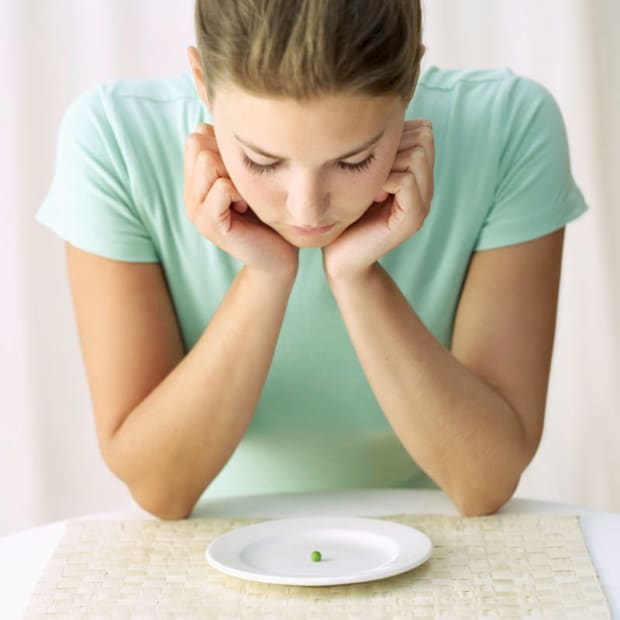- Like
- SHARE
- Digg
- Del
- Tumblr
- VKontakte
- Flattr
- Buffer
- Love This
- Save
- Odnoklassniki
- Meneame
- Blogger
- Amazon
- Yahoo Mail
- Gmail
- AOL
- Newsvine
- HackerNews
- Evernote
- MySpace
- Mail.ru
- Viadeo
- Line
- Comments
- Yummly
- SMS
- Viber
- Telegram
- JOIN
- Skype
- Facebook Messenger
- Kakao
- LiveJournal
- Yammer
- Edgar
- Fintel
- Mix
- Instapaper
- Copy Link
We expect a lot from food. We want it to help us lose weight, lower cholesterol, comfort us when we’re sad, soothe us when we’re anxious, indulge us when we’re deprived, and make us happy when we’re not.
Of course, at its most basic level, food is merely fuel. “But it’s not that simple,” says Karin Kratina, PhD, RD, LD/N, a clinical nutritionist specializing in disordered eating. For example, if you grew up as a member of the clean plate club, or with parents who scolded you for eating certain foods or closely monitored your weight, your current relationship with food can’t help but be skewed. Read through the following common pitfalls—and change your relationship with food for the better.
Eating To Cope
When we use food to meet any need other than physical hunger, we’re eating to cope. “Food becomes a way to focus on something other than what is really bothering us,” says Carmen Cool, MA, LPC, a psychotherapist specializing in binge-eating disorder. “This may work in the immediate short-term, but it doesn’t attend to what we really need.”
Pay attention to what’s really going on when you have the urge to munch. “Mindfulness can be invaluable in learning to differentiate what our true needs and feelings are, and in learning to tolerate feelings,” says Cool. Check-in with your body, advises Cool. Are you really hungry? Or do you need to feed a different kind of hunger—for comfort, for companionship, for connection and love?
Eating For Stress Relief
It’s similar to the eating-to-cope pattern, with a few differences. “When people crave hard, chewy or crunchy foods, like chips, pretzels or cookies, it’s usually in response to a pressure emotion, like stress, anger, frustration, resentment or feeling overwhelmed,” says Linda Spangle, RN, MA, author of Life is Hard, Food is Easy. “The act of chewing on these foods relieves tension in the jaw and eases emotional and mental pressure.” In contrast, if you’re experiencing what Spangle calls “empty” emotions, you’ll usually crave soft, smooth foods, like ice cream or mashed potatoes, that give you a sense of being filled up.
When you have an urge to eat, and you’re not really hungry, noticing what you’re craving—hard and crunchy, or soft and smooth—can give you a clue about what’s really going on. If it’s stress, ask yourself, “What do I need to bite down and chew on in my life?” says Spangle.
Related: Mindful Eating
Food As Reward
If your parents rewarded you with food for good behavior, it’s likely that you’ll do the same as an adult. “The problem is, the things you’re rewarding yourself for doing become less important,” says Kratina. The question, she says, becomes, “What is it you’ve done that’s created a situation where you now can eat chocolate truffles? Has your promotion at work suddenly removed truffles from the list of forbidden foods? And why can’t you just have truffles when you want truffles? Why do you have to earn them?”
It also depends on what rewarding yourself with food looks like. There’s a big difference between getting dressed up and taking yourself out to dinner as a celebration of your success, and buying a box of truffles and eating the whole thing alone in the car on your drive home, says Spangle. She advises considering alternative rewards, such as a weekend yoga retreat or an afternoon matinee—something that includes down time, stress relief, and non-food indulgence.
Chronic Dieting
Characterized by calorie counting, rigid rules around food intake, and sometimes the exclusion of entire groups or types of food, chronic dieting takes you out of the physical experience of hunger and into the mind. If you’re on a diet, when you’ve reached a certain number of calories, or a certain pattern of food intake, you stop eating—even if you’re still hungry— or eat more, even if you’re not hungry.
“Dieting provides a system (and a culturally sanctioned one) for knowing what to do,” says Cool. “It provides a set of rules that tells us if we’re being ‘good’ or ‘bad.’ Dieting also follows a belief that something about my body is ‘wrong,’ and losing weight through dieting is the solution.” It makes food the enemy.
The problem is, deprivation often triggers overeating, says Cool. Many studies have shown that dieters are more likely than non-dieters to binge eat and to eat when they’re not hungry. “Then it becomes a self-fulfilling prophecy,” says Cool. “After overeating, the dieter says ‘See, I knew I couldn’t be trusted around food. I need to go back to restricting.’”
The first step is to stop counting: grams of fat, calories, carbs, whatever it is you count. When you count, you’re judging food, and choosing it according to mental, rather than physical, cues. Start small, by eating one meal a day without counting. After a few days, eat two meals a day without counting. Continue slowly, until you’ve eliminated counting. And remove judgments around food; allow yourself to have a “forbidden” food, but do it in a “safe” place. For example, instead of buying a bag of cookies, go to the bakery, sit at a table, and have just one. Ultimately, what stops dieting is self-love and complete acceptance of your body exactly as it is.
Related: Breaking Free From Binge Eating
Mindless Eating
Munching lunch in the car, eating in front of the television, standing in front of the refrigerator and nibbling out of containers: all of these are forms of mindless eating.
Binge eating is a more extreme form of mindless eating but has a frenetic quality to it, and usually involves “forbidden” foods. The best way to approach binge eating, says Kratina, is to remove judgments around food. “Take away the critical judgments, the ‘I can’t, shouldn’t, won’t eat this,’ and allow yourself free access to all foods,” she says. Over time, this will loosen the grip of forbidden, binge foods.
Also, identify what you’re feeling, and why. Try this exercise, says Spangle: Draw a line down the center of a sheet of paper. On the top left write the heading “I feel…” and on the top right, write “…because.” Then start to write down feelings and their causes. By the time you’ve done a dozen or so, you’ll be much closer to finding out what’s really driving your urge to eat.
According to most studies, the bottom line for improving your relationship with food—no matter what the pattern—is to eat when you’re hungry, stop when you’re no longer hungry, choose whole foods rather than processed foods, and allow yourself “forbidden foods” like chocolate so you don’t end up feeling deprived. And most of all, says Cool, “A healthy relationship with food involves eating in partnership with our bodies, not with a set of rules. It is trusting the wisdom of our bodies to know when to eat, what to eat, and how much.”


